“I’ll be home for Christmas” rang true this year in the U.S. as Christmas Day hotel occupancy (47.3%) was the highest ever recorded by STR. The previous Christmas peak was reached in 2015 (47.0%). The remainder of the holidays were strong as well, but not record-setting in terms of occupancy. New Year’s Eve was likely limited by Omicron, which resulted in limitations or outright cancellations of many large-scale celebrations. Occupancy on that day rose to 62%, which was higher than in 2019 (59.4%), but well below the peak set in 2016 (68.7%). Occupancy for the 7-day period from Christmas Day to New Year’s Eve (53.7%) also did not reach a record and was slightly below the level seen during the same days of 2019. However, total room demand over the holiday week was the highest ever for those seven days as more than 20.6 million rooms were sold.
Market Recovery Monitor - 1 January 2022
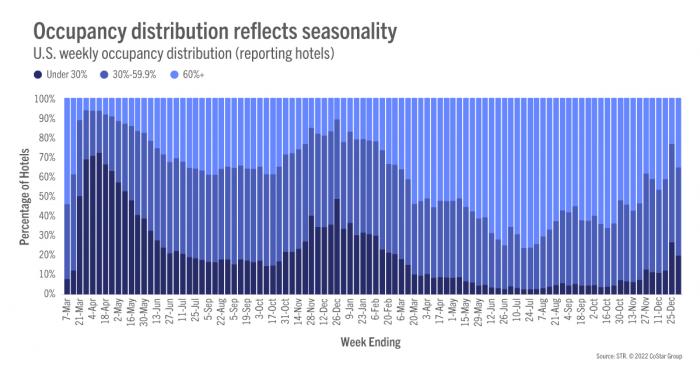
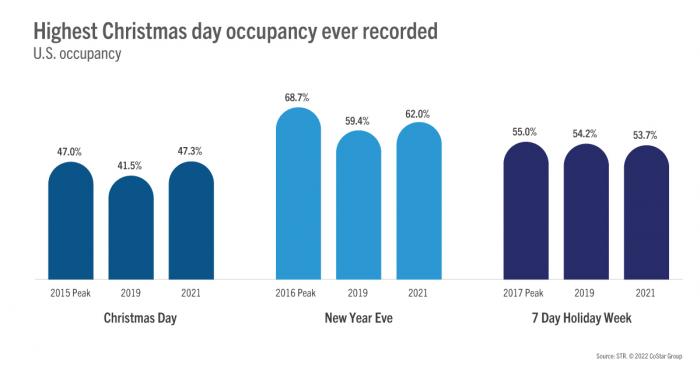
Average daily rate (ADR), on the other hand, skyrocketed. From 26 December 2021 through 1 January 2022, ADR reached US$157.91, which was the highest weekly level ever recorded by STR. Real, inflation-adjusted ADR also reached an all-time high. Other ADR records were set on Christmas Day and New Year’s Eve in both nominal and real terms. The remarkable strength in ADR was led by luxury Class hotels, primarily in resort locations, where ADR reached US$533 for the week. Overall, 165 U.S. hotels reported ADR above US$1,000 in the week with 149 properties in the luxury Class. Of those 149 luxury class hotels, 33 reported weekly ADR above US$2,000 and 18 were above US$3,000.
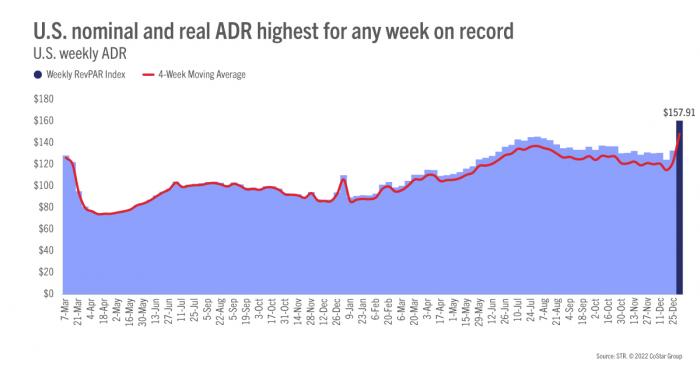
Markets in destination locations did well over the 7-day holiday period, led by the Florida Keys with an occupancy of 89%. Other markets observing strong occupancy included Fort Myers, Gatlinburg/Pigeon Forge (TN), Oahu, Orlando, and Miami. With the reduction of the Times Square New Year’s Eve celebration, along with the temporary closing of many Broadway shows due to staffing shortages caused by Omicron, New York City occupancy was weaker than what had been anticipated, reaching 66% during the holiday period. For comparison, NYC was ahead of Portland, OR (64%) but below Los Angeles (70%). Overall holiday occupancy in the Top 25 Markets was 59% with Houston, Washington, D.C., St. Louis, and Minneapolis all reporting occupancy under 45%. Outside the Top 25, occupancy was slightly lower at 52% as 23 of the STR-defined markets reported occupancy under 40%.
As expected, hotels in resort locations saw the highest occupancy at 71% during the holiday period. Airport locations had the second highest occupancy during the period (60%), likely seeing added demand from the air travel disruptions caused by Omicron and weather. On New Year’s Eve, resort occupancy reached 78%, followed by airport (67%) and urban (67%) hotels.
Market-level ADR was highlighted by Maui (US$1,120), up 17% as compared with the same 7-day holiday period in 2019. The Florida Keys posted the second highest holiday ADR (US$816), which was up 44% from 2019. Among the Top 25 Markets, Miami led with ADR at US$455, up 17%. Oahu followed at US$411 with the next closest market being New York (US$281), which saw ADR fall compared with 2019. Nearly every market in the country saw ADR improve during the holiday period with 68% of all markets seeing double-digit gains. U.S. ADR rose by 9% during the holiday period as compared to the same week of 2019.
With the sharp increase in ADR, revenue per available room (RevPAR) jumped to its highest level of the past 10 weeks. As a result, the RevPAR index to 2019 soared to its highest weekly level of the year (127). On an inflation-adjusted basis, the index was still high at 117. The 28-day figure was also at its highest level of the year (109) with the inflation-adjusted index right at 100. As a result, 89% of all markets were classified as being at “peak” over the past 28 days (RevPAR indexed to 2019 above 100). Another 10% were in the “recovery” category (RevPAR indexed to 2019 between 80 and 100) with only two markets (1%) in “recession” (RevPAR indexed to 2019 between 50 and 80). The strength of RevPAR compared with 2019 was observed over the past three weeks. Even on an inflation-adjusted basis, 80% of markets were in the “recovery” category for the 28-days ending 1 January 2022.

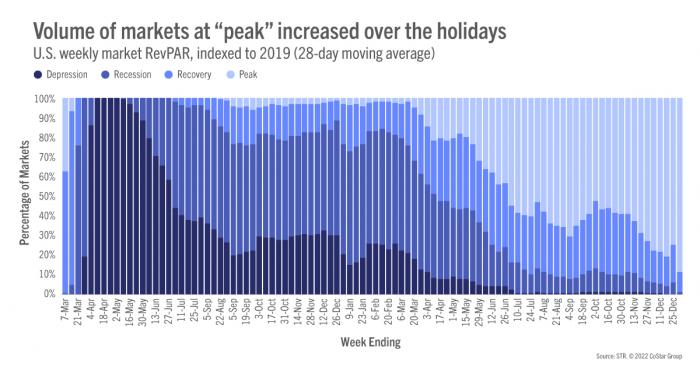
Outside of the U.S.
Occupancy outside the U.S. improved to 49% after falling to 43% in the previous week. The measure was also on the rise in each of the top 10 countries by hotel supply with Japan (62%) leading the pack and Germany (32%) at the bottom. Occupancy in Mexico came in at 57% whereas Canada was at 36%. The U.K. and China both reported weekly occupancy just under 50%.
Many countries saw a solid recovery versus the previous week, particularly across Europe as COVID restrictions were lifted or loosened. Standout countries included Poland, Czech Republic, Hungary, and Belgium, all seeing week-over-week occupancy growth of more than 60%. Austria also benefitted from lockdown lifting, with occupancy up 41% week over week. The exception was Russia, which saw a 16% drop in occupancy, potentially driven by a death toll spike and cancellation of New Year’s events. Most reporting countries outperformed 2021 levels in occupancy (87% of countries) and ADR (84% of countries). Unfortunately, most remained behind 2019 levels for the comparable week.
On a market-level, 64% of markets remained in either “recession” or “depression” in the 28 days ending 1 January. That percentage has changed little over the past 20 weeks.
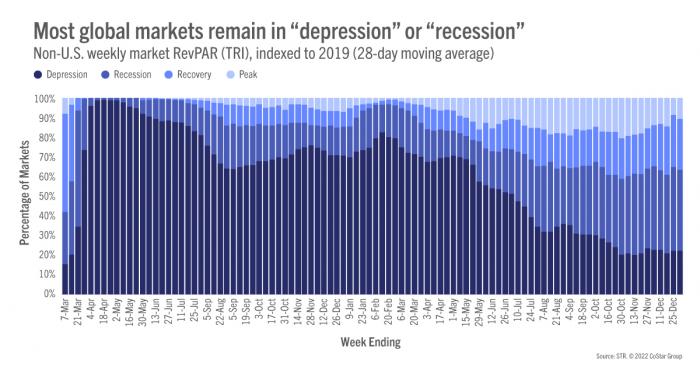
Big Picture
While COVID cases raged over the holiday period, the desire to be with family and friends lifted the hotel industry with solid occupancy and strong ADR, particularly in the last week. We expect that performance will slow in the coming weeks due to the surge in COVID, less conferences, and seasonally-less leisure travel. With limited lockdowns, along with increased COVID apathy, travel—particularly leisure travel—will likely see increased strength by the end of the month. Destination hotels will continue to see better performance than those in urban locations. STR still expects U.S. demand and ADR to top 2019 levels by the end of the year.